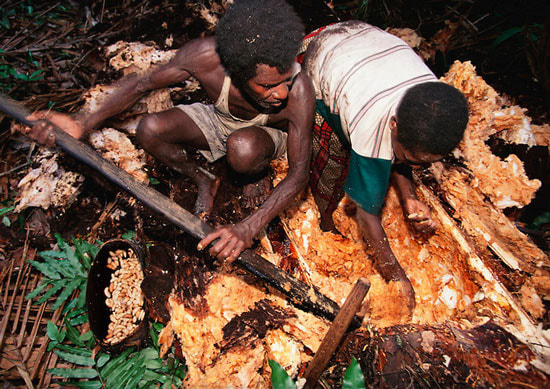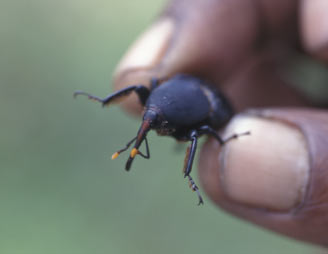|
If you have read any of my novels, you know that Sago grubs are an important part of the diet of Papuan villagers (on the western half of the island of New Guinea, the Indonesian province of Papua). But what the heck is a sago grub? Sago grubs are actually the larvae of a large beetle called the Sago Palm Weevil, a species of snout beetle that feeds on the rotting trunks of the Sago Palm. These beetle larvae can be as fat as your finger. They may look disgusting to anyone who is not accustomed to eating insects, but they are packed with great nutrients and are said to be delicious. Amazing facts about Sago Grubs Sago grubs are considered a tasty treat throughout Indonesia, Vietnam, and Papua New Guinea. The people of some cultures like to eat them raw, and they describe the taste as creamy. Other people like to cook them, and the taste of the cooked grubs is described as resembling bacon or other meat. Of course sago grubs have varying significance for every culture that consumes them. New Guinea is home to hundreds of tribes with different customs, but the ritual of the sago grub feast is common throughout most of these tribes. The sago grub feast is a way to celebrate fertility and prosperity. Sago grub feasts are held at least once during the lifetime of each generation, and one feast can involve a sequence of events that goes on for many months. These feasts are a big deal, to say the least. The host tribe invites numerous guests, based on complex rules of genealogical relationships. These rituals often involve dancing, as well as exchanging valuable gifts such as pigs and shells (among other things). Check out this video of a sago grub feast in Papua. Harvesting sago grubs is amazingly difficult and time-consuming.Tribesmen cut down sago palms (not an easy task in itself). And they return to the fallen trees after 1 to 3 months to gather the Sago Palm weevil larvae (grubs) that have hatched in the trunk and have grown large by feeding on the rotting wood. Splitting open the rotting tree is labor-intensive and takes hours of hard work. If they wait too long to harvest the sago grubs, the larvae will mature and turn into adult Sago Palm Beetles, which are not desirable to eat. Not only are sago grubs tasty, and they play an important role in traditional rituals, but they are also extremely nutritious. Five large sago grubs (weighing about 40 grams total) will contain 3 grams of protein and as much as 12 grams of fat. Palm Weevil grubs have even shown up in hoax news reports. A newspaper in Italy ran a story (and the photo below) of firefighters in Naples finding a larva the size of a full-grown pig. According to the article, the creature let out a shrill cry, similar to the whinny of a horse. Imagine the feast you could have with that one! Of course this is fake. So, the Sago Grub deserves a place in the D.A.H.O.F. (Deevy Animal Hall of Fame). FUN FACT: Deevy is a word extracted from divvy, which in turn was extracted from divine. Deevy was used as early as 1900 (Elinor Glyn used it in her 1900 novel, Visits of Elizabeth). So, in other words, deevy is another way to say awesome. Photo Credits:
Sago Grub in hands - Sean Linnane Collecting Sago Grubs - Peter Menzel Adult Palm Weevil Beetle - Kal Muller Papuan child eating roasted sago grubs - Peter Menzel Giant Larvae Hoax - Musem of Hoaxes
0 Comments
Leave a Reply. |
Stan's Cogitations
Everyone needs a creative outlet. That's why I write. Archives
July 2024
|






 RSS Feed
RSS Feed